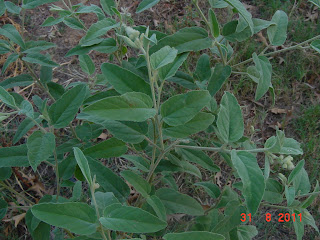 |
| Basil? Yum! |
Apologizes about not keeping up with the Blog. (As I was gently reminded last night!) It has been a couple weeks and I must admit the Winnsboro Farmer's Market is to blame! I have been sooo wonderfully busy making Sister Susan's Homemade Granola, Elderberry Syrup and Ginger Syrup, not to mention the new line of Sister Susan's Beauty Products for Cowgirls and Cowhands! Also, will have quite a few tinctures for sale at the end of September! I love being part of the Winnsboro Farmers Market. The vendors are a fun and friendly lot and the customers are excited about new products and produce....unfortunately this has been an awfully hot and dry year and no one has tomatoes!
But today we will talk about Sweet Basil (Ocimum basilicum). The name "basil" is derived from the old Greek word basilikohn, which means "royal." Basil has been held in high esteem in many other cultures. For instance in India, basil was cherished as an icon of hospitality, while in Italy, it was a symbol of love.
 |
| Sweet Basil with morning sun shining on leaves |
Basil is an excellent source of vitamin K and a very good source of iron, calcium and vitamin A. In addition, basil is a good source of dietary fiber, manganese, magnesium, vitamin C and potassium. Okay, so has anyone ever heard of Vitamin K? According to the website MedLinePlus, Vitamin K is known as the clotting vitamin, because without it blood would not clot. Some studies suggest that it helps maintain strong bones in the elderly. Please, pass the pesto and throw a few (or maybe a handful) of those Basil leaves on my salad!
In a study published in the July 2003 issue of the Journal of Microbiology Methods, essential oil of basil was even found to inhibit strains of bacteria from the genera Staphylococcus, Enterococcus and Pseudomonas, all of which are not only widespread, but now pose serious treatment difficulties because they have developed a high level of resistance to treatment with antibiotic drugs.(September 8, 2003).I am so very happy that Basil has these healthful qualities but let's get busy and make some Pesto!
My Basic Pesto Recipe
2 c. fresh basil leaves, packed
1/4 c. grated Parmesan cheese
1/2 c. Olive Oil
3 Tbls. pine nuts, walnuts or sunflower seeds (We use sunflower seeds)
3 garlic cloves, finely minced
I put the whole lot in the blender and pushed the ON button. The recipe will tell you "add half the ingredients and drizzle the oil." And there is some controversy about adding the cheese or garlic to the freezer batch. Well, I didn't know those things when I started making pesto (a long, long time ago....)
When the pesto is smooth and thick and smelling heavenly, I put it in a large ziplock bag with a tip cut off (please, do the tip cutting after the pesto is in the bag) and then squeeze the green goop into old fashioned ice cube trays and pop it in the freezer for 24 hours. When the pesto is frozen put pesto bricks in a zip lock freezer bag for later use.
I use this pesto in soups and pasta dishes, and Sandra makes pita bread pizzas using the pesto as the sauce instead of a tomato based sauce.
 |
| Off to the freezer for a 24 hour nap! |
Another version of pesto that I like.....Purple Basil Pesto
2 c. Opal or Purple Basil
2 Tbls. Sundried Tomatoes
2 Garlic Cloves
6 Tbls. Asiago Cheese (I just use Parmesan)
1/3 c. Pine nuts or walnuts (Sunflower seeds)
1/2 c. Olive oil
Just use the above instructions.
Pesto can be made with a variety of green herbs. Parsley, cilantro, blends of basil and thyme or sage, and chickweed. I have actually made chickweed pesto and it is very good. That will be a blog entry for next summer. I really don't want to think about next summer!
 Chi decided she needed an early morning swim. In this photo, she is wet and the sun is shining a rosy color on her fur. And I can tell you exactly what she is thinking! MOM, THROW BALL, MOM! THROW BALL, MOM! THROW BALL, MOM! And yes, she is screaming at me!
Chi decided she needed an early morning swim. In this photo, she is wet and the sun is shining a rosy color on her fur. And I can tell you exactly what she is thinking! MOM, THROW BALL, MOM! THROW BALL, MOM! THROW BALL, MOM! And yes, she is screaming at me!Sandra has been very busy the last couple weeks planning and preparing to paint almost all the rooms in our house. (Sounds like work to me!) So while I am in the kitchen making granola or canning syrup she has been painting her bedroom and this week she started painting my bathroom!
 |
| Thank you, Sandra! You are the best cousin in the world and I love my bathroom! |
 |
| Woolly Croton, Doveweed, Goatweed or Hogweed |
Woolly croton is toxic to livestock; it rarely is consumed due to its bitter taste. Some songbirds and squirrels are supposed to enjoy the seeds. And if you have any experience trying to get this weed out of your garden or yard, it will cause minor skin irritation. Wooly Croton is considered a poisonous plant. DO NOT EAT THIS WEED! Also, I Googled Goatweed and was given information on the plant Horny Goatweed. Uhhhh, that will be a different blog!
Till next time, think green! Susan
 |
| Enjoying a morning cup of sweetness! |





No comments:
Post a Comment